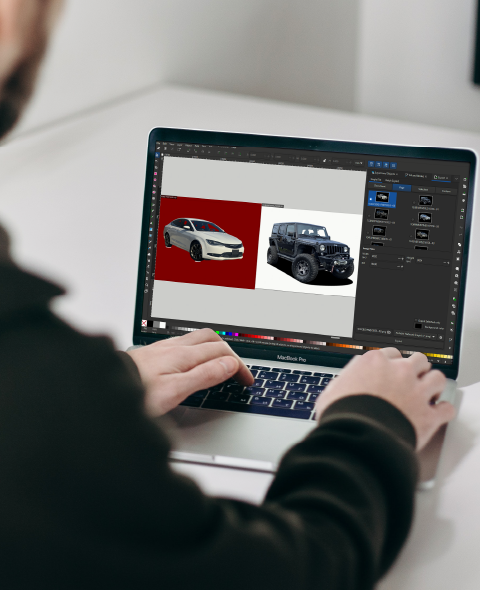AI-Driven Automotive Photo Editing for Realistic Shadows and Window Effects
75%
Reduction in Manual Editing Time< 1 Second
Average Processing Time per Image95%
Accuracy in Shadow and Window RenderingCustomer Overview
A US-based automotive photography giant offered an app that enabled auto dealers to capture professional-grade interior and exterior car photos using 37 standardized angles, which were polished using automated tools and manual editing to deliver high-definition 4K images. Processing over 70,000 images daily, the client’s reliance on a third-party tool for image background removal and replacement increased operational costs. They wanted a scalable, cost-effective, and IP-owned solution.
Project Overview
In our project’s Phase 1, we helped our client replace a costly third-party tool with a custom-built, in-house image background removal and replacement solution, meeting their needs for both images and videos. Building on this success, in Phase 2, the client aimed to automate a key manual photo editing workflow: creating realistic shadows in automotive images. Crafted by professionals, these shadows added visual depth and precision to both interior and exterior shots. The goal was to replicate this human-level creative capability within the tool, add new features, and enhance existing features to show realistic window effects.
Challenges
Building a custom automotive photo editing solution to replicate professional shadow design, show realistic window effects, and adapt to varied car models and angles, while balancing AI with vision engineering and maintaining sub-second processing speeds.
- Consider both the industry standards and our client’s established process for professionally designing car shadows. Generate two types of shadows: a general shadow for the entire car, and separate tire shadows that align with it to make the vehicle appear properly grounded and the overall shadow effect realistic.
- A single shadow design wasn’t viable for all car images, as different car models and camera angles affected shadow shape and direction. Our solution must account for this variability to generate realistic shadows.
- While a hybrid approach combining vision engineering with AI models was necessary, determining the right balance to achieve accurate results was the challenge.
- Existing image annotation tools proved inadequate for the shadow generation use case. Photoshop could help, but using it at scale would increase costs. We needed a cost-effective solution.
- In Phase 1, the system applied the same transparency level to all windows after background removal. The challenge was to detect which windows were tinted or less tinted in the original images, and then apply the correct level of tinting effect to each one.
- Our initial window detection algorithm misclassified the car carrier as part of the window, causing frosted effects to be incorrectly applied to non-window areas.
- Even if the solution uses multiple AI models, maintain response time under one second and ensure fast graphics processing for scalability and performance.
Solution
We designed a hybrid solution for automotive photo editing, combining two custom-built AI models with vision engineering techniques to deliver accurate shadow generation, realistic grounding effects, and precise window effects across all car models and camera angles.
- Leveraging our client’s standards and industry best practices, we defined output quality benchmarks for shadow generation with grounding effect. To achieve this, we used two custom-built AI models and vision engineering techniques.
- Our chosen AI model must generate shadows for all car sizes & photo angles. So, we ran experiments with pix2pix, CycleGAN, Stable Diffusion img2img & Segmentation models, training them on 5000 images from 37 compositions & building PoCs to compare outputs. Stable Diffusion delivered top quality, followed by Segmentation model.
- While the Stable Diffusion model needed minimal vision engineering to meet our quality goals, it was costly to host and too large to support sub-second response times. Contrarily, the Segmentation model needed more engineering support but proved faster and cost-effective. Given our client’s need for performance and scalability within budget, we selected the Segmentation model.
- We fully trained and customized two segmentation models: one to suggest shadow shape and one to identify tire-grounding zones. Later, vision engineering techniques like blur and opacity adjustments were applied to create realistic effects. This decoupled setup enabled independent fine-tuning and balanced computational load.
- To replicate Photoshop-like shadow curves without licensing costs, we adopted Inkscape, an open-source tool. We trained the annotation team on Inkscape, achieving high-quality visual effects within budget and tight timelines.
- To achieve realistic tinted and frosted window effects, we applied vision engineering techniques, like hue and saturation adjustments, blurring, and layered transparency. Built an algorithm to analyze window brightness in the original image and adjust effects accordingly.
- We refined our window identification algorithm such that it now accurately distinguishes windows from non-window areas across car models and compositions.
- Even while employing three AI models for background removal, shadow, and grounding effects, we maintained sub-second speeds by invoking models in parallel. Used GPUs for graphics tasks to support high-volume processing.
Benefits
The AI automotive photo editing solution we developed to generate realistic shadows and window effects delivered the following key advantages:
- Automated a skilled manual workflow, reducing reliance on human editors and improving turnaround time, operational efficiency, and maintainability.
- Delivered consistent, high-quality visual output at scale through a modular system, giving the client a competitive edge in automotive product photography.
- Added advanced visual features like realistic shadows, grounding effects, and tinted windows, increasing the value and extensibility of the IP.
- Enabled real-time responsiveness with sub-second processing, critical for high-throughput, dealer-facing applications and scalable system performance.
Technology
- BiRefNet
- OpenCV
- Python Imaging Library (PIL)
- Python
- Hugging Face
- FastAPI
- Vast.ai
- CVAT.ai
- AWS Sagemaker
Industry
- Automobile/Automotive

Conclusion
By automating shadow rendering and window effects, we helped the client replace a highly skilled manual workflow with a scalable, in-house AI automotive photo editing solution. The system delivered consistent, production-grade visual quality, improved turnaround time, and reduced editing workload. With sub-second response times and modular architecture, the solution strengthened the client’s competitive edge and enhanced the value of their IP. Explore how our AI solutions can help you scale high-precision workflows in your business.
Frequently asked questions
What is AI automotive photo editing and how does it differ from traditional photo editing tools?
AI automotive photo editing uses computer vision and machine learning to automate tasks like background removal, shadow creation, and window tinting in car images. Unlike traditional photo editing, which is manual and time-intensive, AI delivers consistent, high-quality results across large image volumes—faster, cheaper, and at scale.
How does AI handle complex photo edits like shadow and reflection in car images?
AI handles complex car image edits, like shadows and reflections, by using segmentation, depth analysis, and lighting models to simulate real-world conditions. It detects object edges, analyzes surfaces, and generates photorealistic shadows and reflections—faster and more accurately than manual editing.
Can AI editing tools identify different car models and adapt the editing accordingly?
While most AI editing tools apply the same edits to all cars, our advanced AI automotive photo editing system is custom-built to recognize different car models and camera angles, adapting every edit—shadow, highlight, and tint—for authentic, production-grade results.
How accurate is AI in editing car photos compared to professional designers?
The AI editing tool we’ve built achieves over 90% accuracy in tasks like background cleanup, glare reduction, and shadow rendering. While designers still lead in creative finesse, AI consistently outperforms in speed, scalability, and uniformity, making it ideal for bulk car photo edits.
Is AI photo editing fast enough for real-time automotive marketplaces or dealer platforms?
Yes—our advanced AI editing system can process car images in under one second using GPU acceleration, making it fast enough for real-time automotive marketplaces and high-volume dealer platforms.
How does AI determine how much tint or shadow to apply to car windows or body panels?
AI determines tint or shadow levels by analyzing brightness, angles, and transparency, then applies adjustments using learned patterns, hue mapping, and layer blending to ensure visual accuracy and compliance.
Can AI photo editing tools integrate into existing automotive photo workflows or CMS platforms?
Yes. Many solutions are built using APIs (FastAPI, AWS, etc.) and can be integrated into dealership CMSs or product image workflows. Modular designs allow plug-and-play use with minimal rework.
How can AI image editing improve SEO for automotive e-commerce platforms?
AI-edited images load faster, look more professional, and enhance user engagement, leading to better on-site behavior signals like time on page. Optimized images also contribute to Google’s visual search, Core Web Vitals, and AI Overview visibility.


